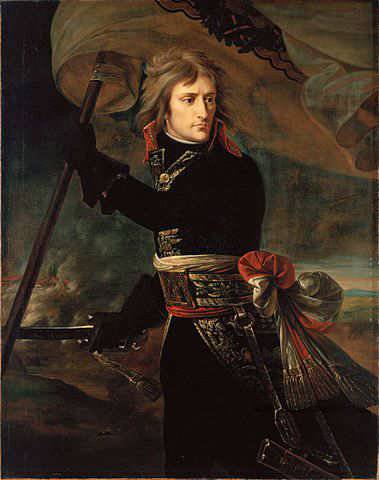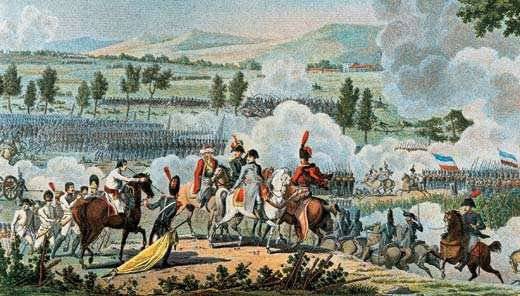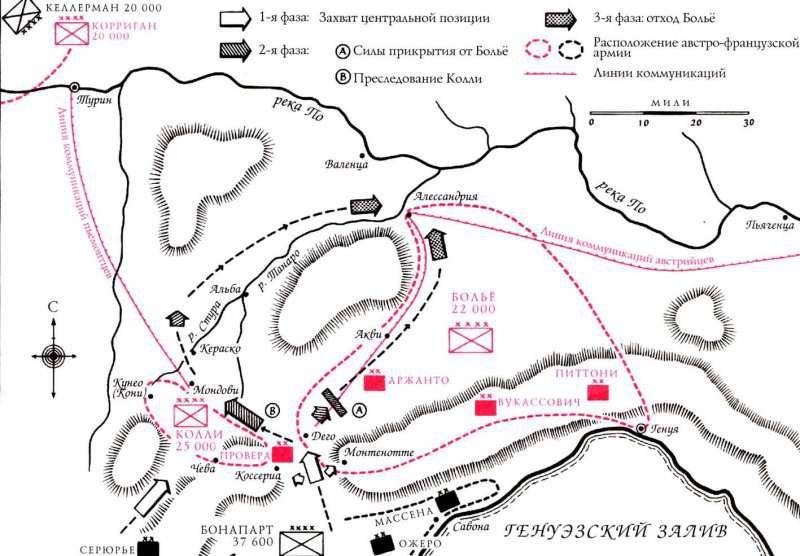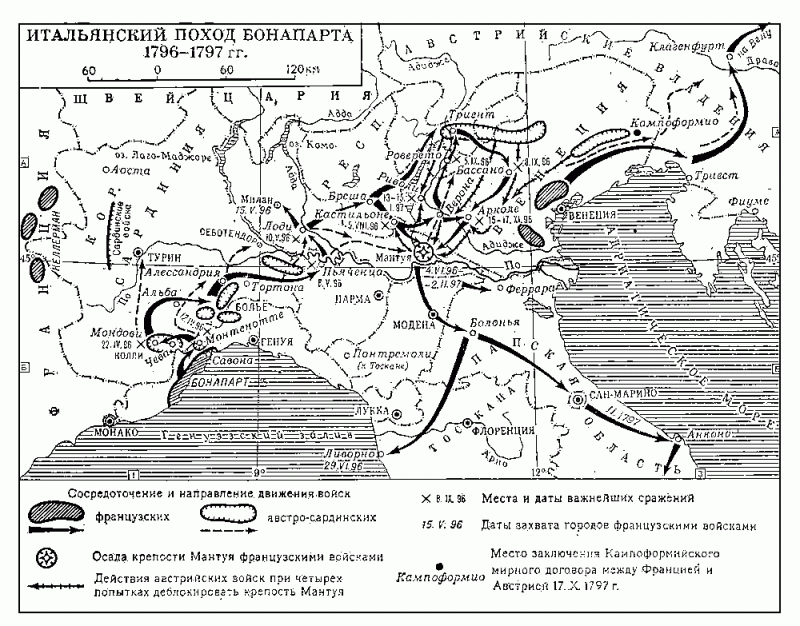The first serious victory of Napoleon Bonaparte. The brilliant Italian campaign 1796-1797's.
 12 April 1796 Napoleon Bonaparte won his first serious victory in the battle of Montenotte. The battle of Montenotta was Bonaparte's first important victory, which he won during his first military campaign (Italian campaign) as an independent commander-in-chief. It was the Italian campaign that made Napoleon's name known throughout Europe, then for the first time, his leadership talent was revealed in all its glory. It is at the height of the Italian campaign that the great Russian commander Alexander Suvorov will say: “He is walking far, it’s time to calm the young man!”
12 April 1796 Napoleon Bonaparte won his first serious victory in the battle of Montenotte. The battle of Montenotta was Bonaparte's first important victory, which he won during his first military campaign (Italian campaign) as an independent commander-in-chief. It was the Italian campaign that made Napoleon's name known throughout Europe, then for the first time, his leadership talent was revealed in all its glory. It is at the height of the Italian campaign that the great Russian commander Alexander Suvorov will say: “He is walking far, it’s time to calm the young man!” The young general dreamed of the Italian campaign. While still the commander of the garrison in Paris, he, together with a member of the Directorate Lazar Carnot, prepared a plan for a campaign to Italy. Bonaparte was a supporter of an offensive war, urging dignitaries in the need to preempt the enemy, the anti-French alliance. The anti-French coalition then included England, Austria, Russia, the Sardinian kingdom (Piedmont), the Kingdom of both Sicilies and several German states - Bavaria, Württemberg, Baden, etc.
The directory (the then French government), like the whole of Europe, believed that the main front in 1796 would be in western and south-western Germany. In Germany, the French were to invade through the Austrian lands. For this campaign, the best French units and generals led by Moreau were assembled. Funds and resources for this army are not spared.
The Directory was not particularly interested in the plan of invasion of Northern Italy through the south of France. The Italian front was considered secondary. It was taken into account that in this direction it would be useful to hold a demonstration in order to force Vienna to shatter its forces, nothing more. Therefore, it was decided to send the southern army against the Austrians and the Sardinian king. The troops should have been led by Napoleon, who replaced Scherer. 2 March 1796 was proposed by Carnot Napoleon Bonaparte as Commander-in-Chief of the Italian Army. The dream of a young general came true, Bonaparte got his star chance, and he did not miss it.
11 March Napoleon left for the troops and 27 March he arrived in Nice, which was the main headquarters of the Italian army. Sherer handed over an army to him and brought up to date: in the army, there were formally 106 thousand soldiers, but in reality there were 38 thousand people. In addition, of these 8 thousand were garrison of Nice and the coastal zone, these troops could not be led to the offensive. As a result, in Italy it was possible to take no more than 25-30 thousand soldiers. The rest of the army were "dead souls" - they died, were sick, were captured, or fled. In particular, two cavalry divisions were officially registered in the southern army, but in both of them there were only 2,5 thousand sabers. Yes, and the remaining troops were similar not to the army, but to the crowd of ragged people. It was during this period that the French Quartermaster Department came to an extreme degree of predation and theft. The army was already considered secondary, therefore it was supplied according to the residual principle, but what was released was quickly and brazenly plundered. Some parts were on the verge of rebellion due to poverty. So Bonaparte just arrived, as he was told that one battalion refused to execute the order for redeployment, since none of the soldiers had boots. The collapse in the field of material supply was accompanied by a general fall in discipline.
The army did not have enough ammunition, ammunition, provisions, money was not paid for a long time. The artillery park consisted of all 30 guns. Napoleon had to solve the most difficult task: to feed, clothe, tidy the army and do it during the march, as he was not going to delay. The situation could be complicated by friction with other generals. Augereau and Massena, like the others, would willingly obey the older, or more honored commander, rather than the 27-year-old general. In their eyes, he was only a capable artilleryman, a commander who served well under Toulon and noted the shooting of the rioters. He was even given a few offensive nicknames, such as “lame”, “General vandemier”, etc. However, Bonaparte could put himself in such a way that he soon broke the will of all, regardless of rank and rank.
Bonaparte immediately and firmly began the fight against theft. He reported to the Directory: "I have to shoot often." But a much greater effect was brought not by executions, but by Bonaparte’s aspiration to restore order. The soldiers immediately noticed this, and discipline was restored. He decided the problem with the supply of the army. The general from the very beginning believed that the war should feed itself. Therefore, it is necessary to interest the soldier in the campaign: "Soldiers, you are not dressed, you are poorly fed ... I want to lead you to the most fertile countries in the world." Napoleon was able to explain to the soldiers, and he knew how to create and maintain his personal charm and power over the soul of a soldier, that their provision in this war depended on them.
Campaign start
5 April 1796, Napoleon moved troops across the Alps. His plan was to defeat the opposing forces separately: first defeat the Piedmontese army, then the Austrian. The enemy was much stronger - Austro-Sardinian forces numbered 80 thousand people with 200 guns. They were commanded by the aged field marshal Beaulieu. In order to win, it was necessary to surpass the enemy in speed and maneuverability, to seize the strategic initiative. Napoleon was not a pioneer in this sphere; Suvorov acted in the same way.
From the very beginning, Napoleon showed bold courage and the ability to take risks. The army went the shortest, but also the most dangerous way - along the coastal edge of the Alps. Here the army was in danger of being hit by the British fleet. The risk paid off; the trip to Karniz on April 5–9, 1796, went smoothly. The French successfully entered Italy. The Austro-Piedmontese command and thought did not allow the enemy to decide on such a risk.

Battle of Montenotta
In order to defeat Napoleon, he had to act as quickly as possible. It was necessary to capture Turin and Milan, to force Sardinia to surrender. Rich Lombardy could provide resources for further campaigns.
The French brigade under the command of General Chervoni attacked Genoa (about 2 thousand soldiers with 8 guns). The Austrian commander decided to crush parts of Chervoni, throwing the French away from Genoa, and then regrouping the troops from Alessandria to strike at Napoleon’s main forces. The division of General D'Arzhanto (Argento) was directed against Chervoni, totaling about 4,5 thousand people with 12 guns.
10 April Austrians approached the French positions near the village of "Night Mountain" (Montenotto). Argento planned to capture Savona and cut the Savona road, which ran along the seashore and led to Genoa. The French were informed by the intelligence that the enemy was approaching and prepared for defense by building three redoubts. In this direction, the defense kept the detachment of Colonel Rampon. Around noon, 11, April, Austrians knocked over the advanced patrols of the French and hit the fortifications. But the French repulsed three enemy attacks. Argento withdrew the troops to regroup them, surround the enemy.
On the same day, the other forces of Chervoni repelled the Beauli attack at the Voltri Castle. A strong position helped restrain superior enemy forces. By the end of the day, Chervoni withdrew and merged with the division of La Harp. At the same time, the detachment of Rampon was reinforced, behind its redoubts they deployed a second line of fortifications.
On the night of April 12, Napoleon threw Massena and Augereau's divisions across the Cadibon pass. By morning, the division of D'Arzhanto was surrounded and in the minority, the French forces had grown to 10 thousand people. Early in the morning of April 12, the French hit the Austrians: General La Harpe led a frontal attack on the enemy’s positions, and General Massena hit the right flank. When D'Arzhanto realized the danger of the situation was too late. The Austrian division suffered a complete defeat: about 1 thousand people were killed and wounded, 2 thousand were captured. 5 cannons and 4 banners were captured. Losses of the French army - 500 people killed and wounded.
This was Napoleon's first victory during the Italian campaign, which set the tone for the entire campaign. Bonaparte later said: "Our lineage comes from Montenotto." Victory in the battle of Montenotta was of great psychological importance for the French army, half-starved, raspyutye French soldiers believed in themselves, defeating a strong opponent. Beaulieu began to withdraw his troops and the French commander-in-chief was able to strike at the Sardinian troops.

Further course of the campaign
Napoleon, after giving the troops a short rest, led them further and two days later in the battle of Millezimo (April 14 1796) defeated the Sardinian army. Five Sardinian battalions with 13 guns surrendered, the remnants of the Sardinian army fled. Not allowing the enemy to recover, Napoleon continued the offensive. In April, the French army won three more victories: the battle of Dego (April 15), the battle of San Michele (April 19), the battle of Mondov (April 22).
The commander retained his basic principles that led him to victory: rapid concentration of forces for a decisive blow, moving from solving one strategic task to another, defeating the enemy’s troops in parts. Napoleon showed in Italy the ability to combine politics and military strategy into a single whole. He remembered all the time that it was necessary to force Piedmont to a separate world so that only one enemy remained - the Austrians. After the battle of Mondovi and the seizure of this city, the Piedmonte general Colley began peace negotiations. 28 April truce with the Sardinian kingdom was signed. 15 May in Paris was signed peace with Sardinia. Sardinians had to accept very harsh conditions: Piedmont pledged not to let anyone’s troops, except French, pass through its territory to supply the French; do not make alliances with anyone; inferior to France the county of Nice and the whole of Savoy; the border between France and the Piedmont was “corrected” in favor of the French.
The first part of the task was completed - the Austrian troops remained in northern Italy without an ally. Napoleon's army threw the Austrians back to the River Po, forcing them to retreat east of the river. The French forced the Po and continued the offensive. All Italian courtyards were alarmed; they were afraid of such a rapid movement of the revolutionary army. The Duke of Parma, who, in fact, did not fight against the French, was the first to suffer. Bonaparte did not listen to his admonitions and did not recognize his neutrality. Parma was to pay an indemnity of 2 million francs in gold and deliver the 1700 horses.
Moving on, the French army reached the town of Lodi, where it was a crossing over the river Addu. This important point defended 10-th. Austrian corps. 10 May 1796, the famous battle of Lodi took place. Here Napoleon showed his fearlessness in battle. The worst fight was at the bridge, where the Austrian 20 guns and arrows simply swept away all the bridge and near it. Napoleon led the grenadier battalion and took the bridge, dropping the enemy. The Austrians lost about 2 thousand killed and wounded, 15 guns.
15 May the French entered Milan. In June, Bonaparte occupied Modena, Murat’s detachment captured Livorno, and Augereau occupied Bologna. The duchy of Tuscany was hit. Bonaparte did not pay any attention to the neutrality of the Italian states. He occupied cities and villages, requisitioned everything necessary for the army. He took away everything he considered necessary, from cannons, guns and ammunition, to paintings by masters of the Renaissance. He looked condescendingly at the looting of his soldiers, which led to petty outbursts of discontent among the local population, but the matter did not come to a big uprising. Most of the inhabitants of the Italian states saw in Napoleon and his army revolutionaries who carried the ideals of freedom, equality and fraternity, liberators from Austrian rule. Moreover, Napoleon reacted harshly to attempts at resistance, eliminating them in the bud. When a mob killed 5 French dragoons in Lugo (near Ferrara), the city was punished: several hundred people were hacked to pieces, the settlement was given to the soldiers for looting.
Having considerably strengthened the artillery fleet of the army with guns and ammunition seized from the Austrians and neutral Italians, Napoleon led the troops to the fortress of Mantua. This fortress was considered one of the strongest in Europe. Starting the siege of Mantua, Napoleon received news that 30-ths went to the aid of the besieged. Austrian army under the authority of a talented General Wurmzer. The situation was dangerous. Piedmont monitored the situation and with a serious failure of Napoleon, could cut communications with France. Catholic clergy and nobility were afraid of the revolutionary army. Italy could embrace anti-French uprising. Citizens and peasants who were severely affected by robbery and violence could support the upper classes.
Napoleon sent one of his best generals, Massena, against the Austrian army. But Wurmzer dropped it. Detachment Auger was also reflected. The Austrians, triumphing in victory, entered Mantua, removing the siege from it. However, at this time, Napoleon attacked another Austrian group, which acted on the reports of the French with Milan and in a series of battles, defeated it. Wurmzer, learning of this, left Mantua and broke several French barriers, on August 5 met with Napoleon at Castiglione. The Austrians suffered a heavy defeat. The French made a maneuver, and went to the rear of the enemy. Wurmzer after a series of new fights, with the remnants of the army locked himself in Mantua. The French resumed the siege.
In Austria, for the revenues of Wurmzer and Mantua, they hurriedly equipped a new army under the command of Alvinci, another Austrian military talent. 15-17 November 1796, the stubborn and bloody battle of Arcol took place. There were more Austrians than French, moreover, they fought very well, there were the best regiments of the Austrian Empire. One of the main battles took place on Arkolsky Bridge, here the situation repeated as in the battle of Lodi. The French stormed the bridge three times, and threw them back with heavy losses three times. Then the attack with a banner in his hands led by Napoleon. Near him fell several soldiers and adjutants, but he survived. The bridge was taken, and the battle ended in victory for the French army. The Austrians were defeated and rejected.
14-15 January 1797 in the Battle of Rivoli, Napoleon defeated the Austrian army decisively. Alvinas retreated and did not even think about the liberation of Mantua. Two and a half weeks later, after the victory at Rivoli, the fortress capitulated. Napoleon led the troops to the north, threatening the Austrian possessions proper. The Archduke Charles was urgently summoned to the Italian front. It was one of the best Austrian commanders. In early spring, Napoleon defeated Carl, throwing him back to Brenner. Panic even began in Vienna: “Napoleon at the gates!” The defeats of several armies and the best generals of the empire, the loss of Northern Italy and the threat of Austria itself came as a shock to the Vienna Court. The name of Napoleon became known throughout Europe.
Even before the defeat of the army of Charles, Napoleon ended Rome. Pope Pius VI looked at Napoleon as a fiend and helped Austria in every way. After the fall of Mantua and the liberation of the troops, the French commander led the army on a punitive expedition. In the first battle, the French defeated the papal army. Napoleon occupied the city outside the city in the Papal States. Cities, monasteries and churches were mercilessly plundered. In Rome, panic began, wealthy people and higher clergy ran to Naples. Dad begged for peace. 19 February The 1797 was signed a peace treaty in Tolentino. Rome lost a significant and richest part of its possessions, paid a contribution to 30 million francs in gold, gave the best works of art from its museums. Napoleon did not enter Rome and did not dislodge the Pope, so as not to disturb Catholic Italy, he needed a calm rear, a battle with the family of the Archduke Charles was forthcoming. Besides, he already became a politician and understood the role of Rome in the governance of Europe.
In May, Bonaparte 1797, on his own, without waiting for the envoys of the Directory, concluded a truce with the Austrians. October 17 The 1797 year in Campo Formio was signed peace between France and Austria. The Venetian Republic was destroyed by the French. The merchant republic, which has many centuries of rich stories, ceased to exist. Actually Venice was ceded to the Austrians, and possessions on the mainland were annexed to the Tsizalpinsky Republic, which was created and controlled by the French. Vienna ceded the banks of the Rhine and the Italian lands occupied by Napoleon’s army.
The directory turned a blind eye to the general-politician who behaved so freely. The Austrians beat the Rhineland army of France and the best Republican generals, including Moreau. More and more money was spent on the Rhine army, and there was little confusion. Napoleon, having accepted a mob of ragged people, turned it into a first-class army, which smashed one after another the Austrian and Italian armies. Napoleon did not require anything, on the contrary, he sent millions of gold to Paris, and millions in works of art, loot good. He forced the mighty Austrian empire to ask for peace. A series of brilliant victories, the capture of Mantua, the seizure of papal possessions, finally made the authority of the commander indisputable.
Sources:
Manfred A. Z. Napoleon. M., 2002.
Tarle E.V. Works in 12 volumes. Tom 7. M., 1957 — 1962.
Chandler D. Napoleon's military campaigns. M., 1999.
http://topwar.ru/13352-nasha-rodoslovnaya-idet-ot-montenotto-pervaya-sereznaya-pobeda-napoleona-bonaparta.html

Information